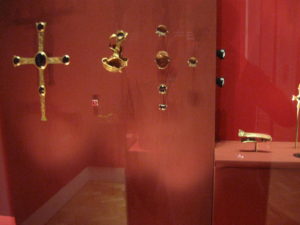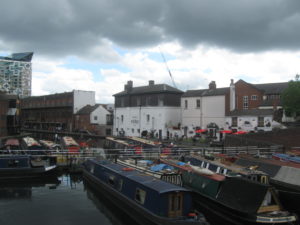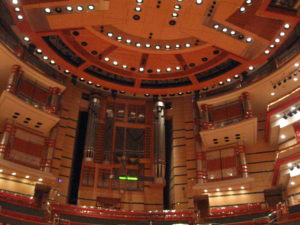It is some years since I heard the Staffordshire Hoard described by the archaeologist who’d excavated it; to see it was an ambition to aim for. The chance came with tickets for Symphony Hall that required a room for the night. We made it two nights and set the day of the concert for our visit to the museum.
The heat wave was over so there was no risk of arriving at the concert sticky. Had it not been we would still have made a leisurely way to the museum, starting with coffee in the Edwardian Tearoom before the Hoard, leaving Pre-Raphaelites and other parts of the display for after lunch. It was cool enough inside; there were not many visitors, so we had a good look round before our coffee. The tearoom is a museum in itself, fit to rival Betty’s in Harrogate. On a squishy seat there’s leisure to admire not just the space but the balcony above, which had examples of iron work and, as I discovered later, some of the most exciting contemporary design in the country.
By lunchtime we began to wonder if we would find another comfortable seat. There is a great movement towards the tearoom, suggesting that although the museum had seemed scantly attended there were plenty of visitors dispersed about its various galleries. No problem in the event. We had a very light lunch after our full English breakfast and wanted to leave room for an evening meal during the long interval of the concert.
Craft and technology are central to the museum, as to Birmingham itself, so while we made straight for the Hoard any comments on it are best held in reserve. Innovative displays bring together crafts from disparate cultures under themes such as calligraphy and utility. It was good to see people such as David Peace and the Kindersleys we had known in Cambridge. There was, as expected, William Morris. So was the Martin Pottery with its almost Lewis Carroll take on animals and birds. The staircase to the balcony displays had precision-cut wood blocks about one cubic inch in size, well worth a study in themselves. They could have been single-letter printing blocks. The lighting in the hall had been by gas, the holders so high they must have had pilot lights to ignite them as the gas began to flow.
Birmingham has the foremost collection of Pre-Raphaelies but these are almost matched by their contemporaries and successors. “The Last of England” and the Arthurian and other legends draw the eye but there are Biblical scenes and the magnificent “King Cophetua and the Beggar Maid” too. Each one is worth a good deal of attention, except that the portraits are irresistible.
So to the Hoard: first there was a film of the work necessary to conserve it before display. Much remains to be disentangled from the mud and jumble of the find site. In some cases items are too fragile to restore to their original form so replicas have been made to show alongside the original. This is the case with the pectoral cross.
Sword decorations are now thought to have belonged to many weapons rather than the few that fitting them together had suggested. Microscopes and magnifying glasses give a detailed view of some tiny objects so that their craftsmanship can be appreciated. If details are too small for us to perceive without help how, I wonder, did their makers achieve such minute delicacy?
By far the largest number of objects are fragments, in some cases recognisable as snakes, horses’ heads or birds but others as scraps or splinters of gold. Every one is worked on in detail, however. Their use may never be determined but their artistry is clear to all.
The display also includes interactive opportunities for children, from Anglo-Saxon costume to runic script and board games. We watched one young visitor seize on the nine-men’s morris and invent his own version – even if he could read English was clearly not his first language: but the language of childhood is universal.
Received opinion is that an hour or two in a museum is enough for anyone. We think, given such as the Edwardian Tearoom for refreshment, that two hours can become three or four without surfeit. Our extended stay did nothing to diminish our delight in the evening’s concert, and still gave us time for the canal basin and a further gentle walk.





